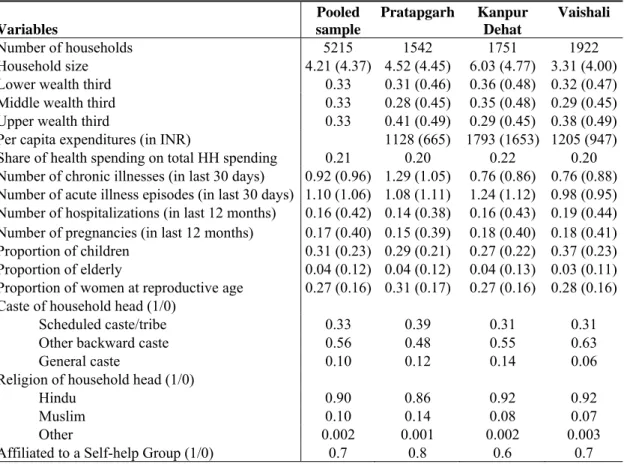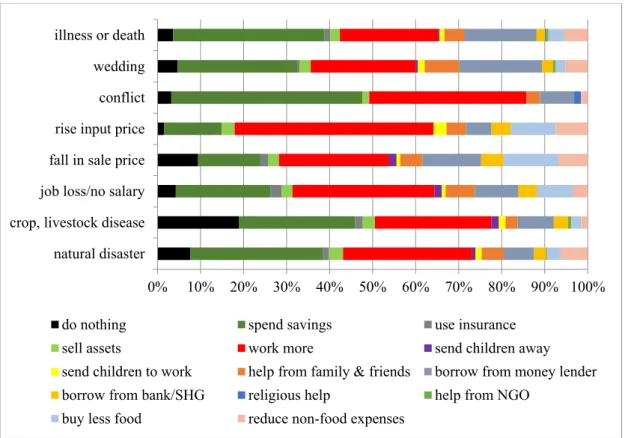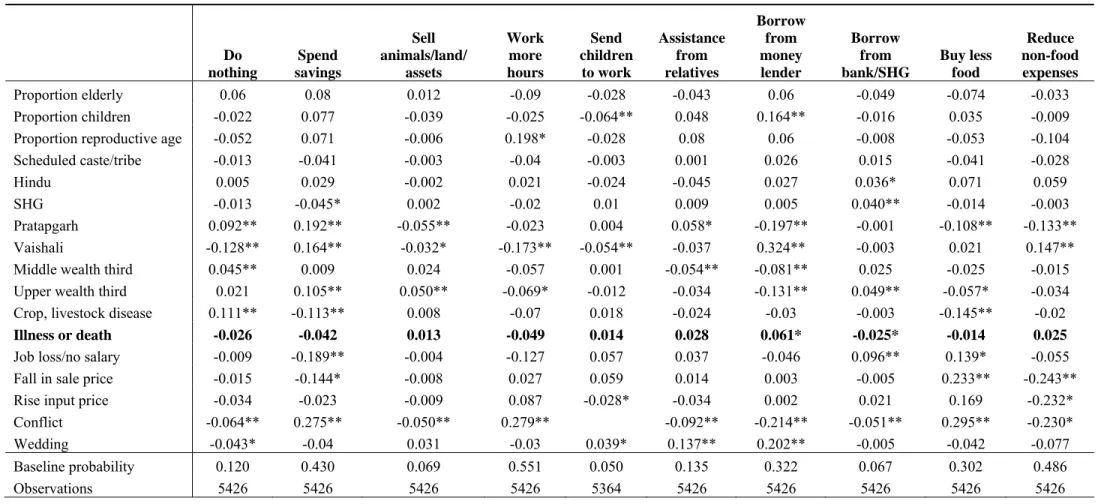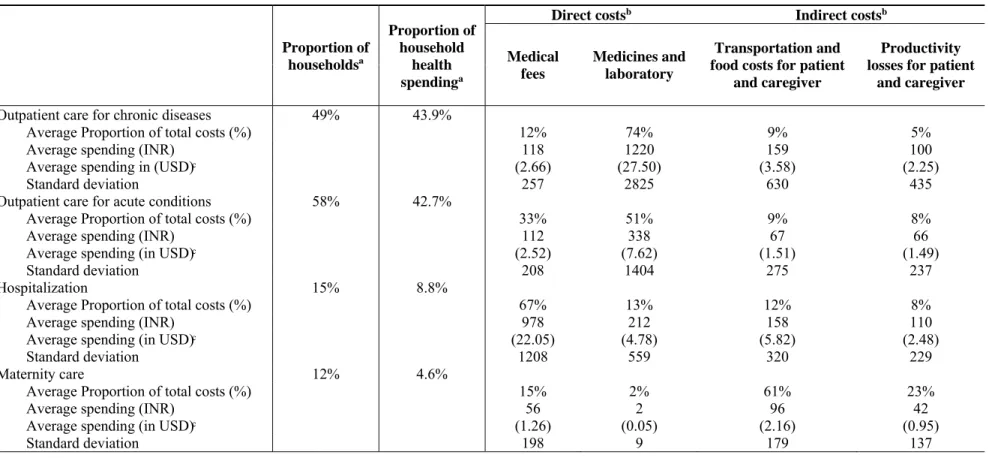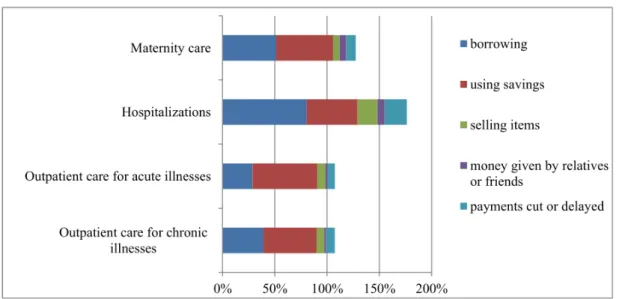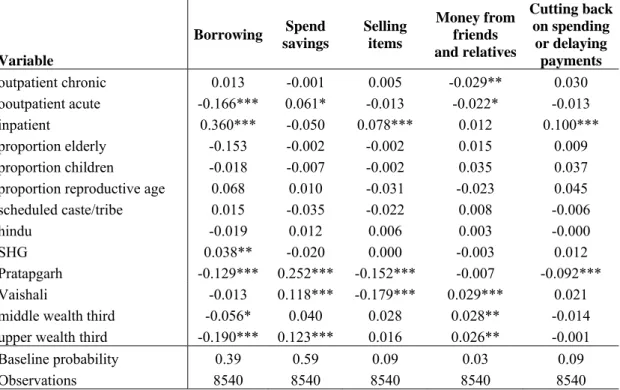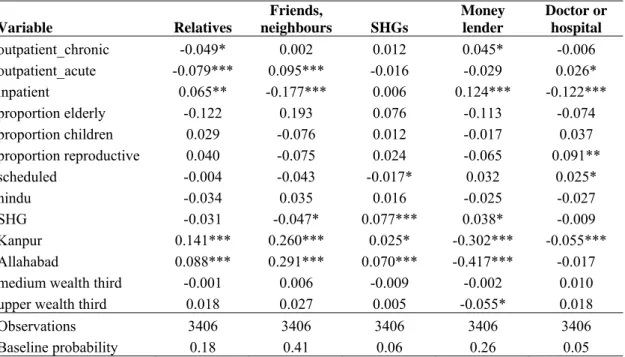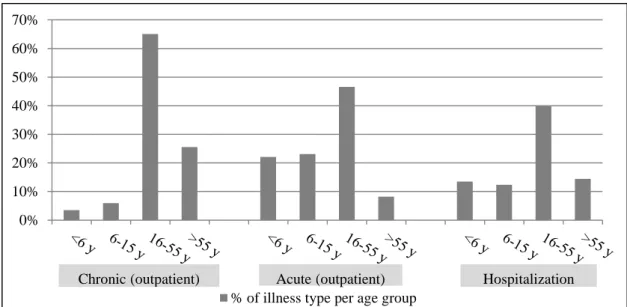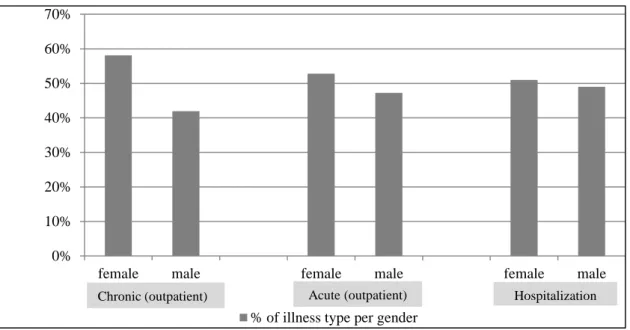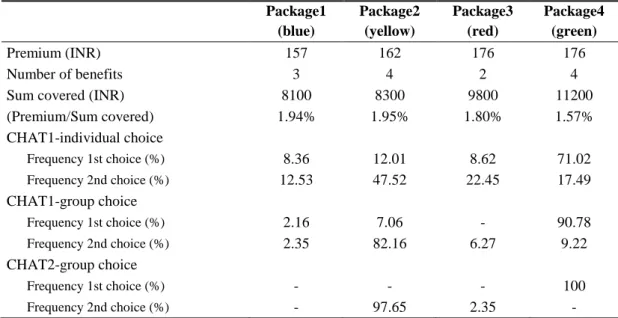STUDIES ON HEALTH CARE EXPENDITURES AND INCLUSIVE HEALTH INSURANCE SYSTEMS FOR
LOW-INCOME GROUPS IN INDIA
Inauguraldissertation zur
Erlangung des Doktorgrades der
Wirtschafts- und Sozialwissenschaftlichen Fakultät der
Universität zu Köln 2014
vorgelegt von Marta Schmidt, M.Sc.
aus Figline Valdarno
Referent: Prof. Dr. Hans Jürgen Rösner (em.) Korreferent: Prof. Dr. Frank Schulz-Nieswandt Tag der Promotion: 8. Januar 2015
I
TABLE OF CONTENTS
LIST OF TABLES III
LIST OF FIGURES IV
LIST OF ABBREVIATIONS VI
ACKNOWLEDGEMENTS VIII
1 INTRODUCTION 1
2 ECONOMIC CONSEQUENCES OF ILL-HEALTH FOR HOUSEHOLDS IN NORTHERN RURAL INDIA
12
2.1 Background 12
2.2 Methods 13
2.3 Results 16
2.3.1 Household shocks module 16
2.3.2 Household health care-related expenditures 21
2.3.2.1 Costs composition 21
2.3.2.2 Coping with health expenditures 23
2.3.2.3 Foregone care 26
2.4 Discussion 27
2.5 Conclusions 29
3 GROUP HEALTH INSURANCE CHOICES IN RURAL INDIA 30
3.1 Introduction 30
3.2 Data 31
3.3 Health care scenario and local context 32
3.4 Study design and methodology 36
3.4.1 The CHAT tool and the package design 37
3.4.2 Data analysis approach 40
3.5 Results 41
3.5.1 First trial – Pratapgarh district 42
3.5.2 Second trial – Kanpur Dehat district 47
3.5.3 Third trial – Vaishali district 49
3.6 Evaluation of the CHAT tool 56
3.7 Correspondence between CHAT choices and enrolment decisions 58
II
3.8 Discussion 61
3.9 Conclusions 65
3.10 Appendix 66
4 INSURANCE FOR THE POOR IN INDIA: THE ROLE OF PRIVATE INSURERS IN THE LOW-INCOME MARKET
71
4.1 Introduction 71
4.2 The Indian insurance scenario 72
4.3 The MI market 76
4.3.1 Regulation and supervision 76
4.3.2 MI distribution models for commercial insurers 79 4.3.3 Developing innovative MI models: An empirical analysis 82 4.3.4 Micro health insurance products offered by commercial
insurers
88
4.4 Challenges for commercial insurers in the MI market 95
4.4.1 Defining target customers 96
4.4.2 Developing the right product 97
4.4.3 Financial sustainability 98
4.4.4 Creating awareness and getting people´s trust 100 4.4.5 Moral hazard, adverse selection and fraud 101 4.5 Extending health insurance to the poor: A business ethical issue? 102 4.6 Gains and risks for commercial insurers entering MI business 108
4.7 Discussion 113
4.8 Conclusions 116
5 CONCLUDING REMARKS 117
BIBLIOGRAPHY X
CURRICULUM VITAE XXII
III
LIST OF TABLES
2.1 Summary statistics on the household level for the pooled sample and across sites.
17 2.2 Descriptive statistics of household shocks. 18 2.3 Determinants of coping strategies for various household shocks
(marginal effects from probit regression).
20 2.4 Distribution of households’ health-related expenditures across the type
of care.
22 2.5 Determinants of coping strategies for various types of health care. 25
2.6 Determinants of HHs´ borrowing behavior. 26
3.1 Description of packages and choices in the first trial (Pratapgarh district).
44 3.2 Relative Risk Ratios from multinomial logistic regression on the
package choices for the first trial.
45 3.3 Description of packages and choices in the second trial (Kanpur Dehat
district).
48 3.4 Description of packages and choices in the third trial (Vaishali district) 51 3.5 Relative Risk Ratios from multinomial logistic regression on the
package choices for the third trial.
52 3.6 Comparison of benefits included in the three community packages and
price ranking within the range of packages offered in the relative CHAT board.
55
4.1 Health insurance premium. 75
4.2 Rural and social sector obligations. 76
4.3 IRDA parameters for micro health insurance products for the general insurance segment.
78 4.4 Summary of pros and cons of the agent model vs the partner-agent
model.
81 4.5 Main features of the micro health insurance product. 83 4.6 Yearly program outreach in terms of new enrolments and renewals
(expressed in No. of families) vs yearly project targets.
86 4.7 Summary of successful features and challenges of the CARE-Bajaj
Allianz mutual scheme.
88 4.8 Micro health insurance products offered by commercial insurers as of
March 2014.
90 4.9 Overview of the CSR activities undertaken by commercial insurers
active in India in the FY 2012-13.
104
IV
LIST OF FIGURES
2.1 Distribution of the most dominant coping strategies for various adverse events.
19 2.2 Relative importance of coping strategies for financing health-related
expenditures by type of care.
24 3.1 Distribution of health care-seeking episodes among age groups in the
total population. Data from baseline household survey (pooled sample of the three sites).
35
3.2 Distribution of health care-seeking episodes among female and male individuals. Data from baseline household survey (pooled sample of the three sites).
36
3.3 Round version of the CHAT board (Source: Danis et al., 2007). 66 3.4 CHAT board at Pratapgarh district (English version). 43 3.5 CHAT board at Kanpur Dehat district (English version). 47 3.6 CHAT board at Vaishali district (English version). 50 3.7 Spreadsheet of the calculator used during the benefit options
workshops.
66 3.8 Description of the phases of the CHAT method for eliciting people´s
preferences for health insurance packages (to be read from the left to the right).
67
3.9 Self-reported reasons for individual choices for the pooled sample (N=184) of respondents of the exit questionnaire (20% of CHAT participants in each site).
55
3.10 Self-reported reasons for group choices for the pooled sample (N=201) of respondents of the exit questionnaire (20% of CHAT participants in each site).
56
3.11 Self-reported evaluation of the project activities (in percentage of total responses on a subsample of 20% of CHAT participants).
57 3.12 Paths of preference transitivity from the individual choices, to the first
and second group choices and to the final community package (each respectively represented in one level of the three-graph) in the second site (Pratapgarh district).
68
3.13 Paths of preference transitivity from the individual choices, to the first and second group choices and to the final community package (each respectively represented in one level of the three-graph) in the second site (Kanpur Dehat district).
69
3.14 Paths of preference transitivity from the individual choices, to the first and second group choices and to the final community package (each respectively represented in one level of the three-graph) in the third site (Vaishali district).
70
3.15 Self-reported reasons for joining (A) or not joining (B) the CBHI scheme in percent of total responses on a random subsample of 20% of CHAT participants.
60
4.1 Structure of the Indian insurance industry. 73
4.2 Segment-wise premium for general insurance for the FY 2012-13. 74 4.3 Market share of the general insurance sector among private and public
insurers in the FY 2012-13.
75
V
4.4 World population classified according to the income level and the corresponding risk protection schemes.
97 4.5 Possible scenarios for private profits vs public interests. 107 4.6 The classification of inclusive business in regard to for-profit and
social business.
109
VI
LIST OF ABBREVIATIONS
ASHAs Accredited Social Health Activists BAIF Bharatiya Agro Industries Foundation BPL Below poverty line
CBHI Community-based Health Insurance CGHS Central Government Health Scheme CHAT Choosing Healthplans All Together CHC Community Health Centre
CI Concentration index
CSR Corporate Social Responsibility EAG Empowered Action Group
ECCP Economic Cross-Culture Program ESIS Employee State Insurance Scheme
FY Financial Year
GDP Gross Domestic Products
GHPC German Health Practice Collection GIZ Gesellschaft für Internationale Zusammenarbeit GoI Government of India
HH Household
ICD International Statistical Classification of Diseases ILO International Labour Organization
INR (Rs) Indian Rupees
IRDA Indian Insurance Regulatory Agency LMP Local Medical Practitioner
MFI Micro finance institution MHI Micro health insurance MI Micro insurance
MIA Micro Insurance Academy
NCD Non-communicable diseases
n.d. No date
NGO Non-governmental organization
NHP National Health Policy
VII
NRHM National Rural Health Mission NUHM National Urban Health Mission OOP Out-of-pocket PHC Primary Health Center RR Relative Risk Ratio
RSBY Rashtriya Swasthya Bima Yojana (National Health Insurance Programme)
SC Sub-Center
SES Socioeconomic status
SHG Self-Help Group
UP Uttar Pradesh
USD United States Dollar
WTP Willingness to pay
VIII
ACKNOWLEDGMENTS
First of all, I would like to thank my supervisor Prof. Emeritus Dr. Hans Jürgen Rösner for his extremely supportive guidance and advice. I would like to thank him for trusting in my potential, for encouraging me and for supporting my PhD project in all phases. Additionally, I would like to express my thanks for offering me the chance to collaborate with him and his research assistants in a very friendly and stimulating working group. I also thank his research assistants Mrs. Christina May and Dr. Katja Roth for the nice time together and the very helpful advice and support for my research. A particular thank to Prof. Dr. Frank Schulz-Nieswandt for his helpfulness and kindness.
This thesis was prepared within the PhD Fellowship Program of the Cologne Graduate School in Management, Economics and Social Sciences (CGS), which has provided research funding and assisted all the phases of my research. I would like to thank the scientific board of the CGS for believing in my potential. I owe particular thanks to Dr. Dagmar Weiler and Mrs. Susanne Ludewig-Greiner, who always showed kindness and were very supportive in several relevant matters. I also thank all PhD Fellows at the CGS for the nice and fruitful time together, and all student assistants for their effort in making our work easier.
The first two studies presented in Chapter 2 and 3 are based on a case study using data from a common research project involving the Department of Cooperative Studies of the University of Cologne, under the supervision and coordination of Prof. Emeritus Dr. Hans Jürgen Rösner, the Institute of Health Policy and Management of the Erasmus University of Rotterdam, under the supervision of Prof. Frans Rutten, PhD, and the Micro Insurance Academy (MIA), a non-profit organization and research center based in New Delhi, directed by Dr. David Dror. The MIA is an internationally recognized leader in the field of micro insurance, by providing relevant implementation support, training, research, and advisory services for the development of international and local pro-poor micro insurance schemes, with the mission to bring insurance coverage to the world’s poor. The project was funded through the EU-FP7 research grant HEALTH-F2-2009-223518 CBHI India on „Developing efficient and responsive community based micro health insurance in India“ for the years 2009-
IX
2014. Three Indian NGOs (BAIF, NIDAN and Shramik Bahrti), based in the northern states of Uttar Pradesh and Bihar, have locally partnered the project and have actively worked in the implementation, management and supervision of the community scheme. The project research team was divided into a qualitative research group, a quantitative research group and an implementing research group. The two studies presented in Chapter 2 and 3 served as contribution for the research targets covered by the quantitative group (including researchers from the Erasmus University of Rotterdam and from the MIA), under the local coordination and supervision of Prof.
Emeritus Dr. Rösner. The author of this PhD thesis was involved in the project as externally funded associate researcher.
I would like to acknowledge the vital role of the team of researchers from across all project partners, who have worked to design and implement the research project that has allowed me to conduct the studies presented in this thesis. I would like to thank the staff at MIA for their kindness and support during my stay in India. I owe special thanks to Dr. Van de Poel for her enormous support and guidance during the first phases of research. I heartily thank all women from the SHGs for their time and kindness.
Within my research work for the CBHI India project I have conducted two field research visits to India (September-October 2011 and February-March 2012), combining research phases at the main office of the partner MIA in New Delhi and field research phases in the project regions, and a research stay at the partner institution, the Erasmus University of Rotterdam (November-December 2010). I particularly thank the Verein zur Förderung der genossenschaftswissenschaftlichen Forschung an der Universität zu Köln e.V. for funding my first research stay in India and the CGS and the DAAD for supporting my research stay in Rotterdam.
The three studies included in this thesis are currently in the publication process.
1
1 INTRODUCTION
In India, health care is still mostly financed through high out-of-pocket payments at the point of use. The consequences are a reduced access to care and high vulnerability (especially for low-income households), due to inadequate financial protection. Several studies show the impoverishing effects of health expenditures on poor households in India (Van Doorslaer et al., 2006;
Vaishavi and Dash, 2009; Gosh, 2010). Despite the fast growing economy, the major part of the country suffers from a poor standard of health care infrastructure and from an unequal distribution of access to health care. The Indian public health spending is very low for a country where a big part of the population depends on public health services. Total health expenditures amount to 4.1% of GDP, of which only 33.1% are governmental funding, while the main part is represented by out-of-pocket expenditures (WHO, n.d.). The results are a weak and obsolete public health care infrastructure, poor quality of preventive care and poor health status, especially for low-income groups resident in rural areas.
In India, public spending on health care is divided between the central government and the single state governments. However, the Constitution (Part XI) assigns a predominant responsibility for the provision of “public health and sanitation, hospitals and dispensaries” to the single states. Public health care provision is mostly tax-financed and oriented toward universal health care.
However, the financing of the public health system is very challenged, since more than 90 per cent of workforce and about 50 per cent of GDP are accounted for by the informal sector (GoI, 2012a). Furthermore, the financing of health care services is affected by a severe fiscal imbalance between the central government and the states, since the majority of tax-revenues (excluding sales tax) are collected at the central level. The Ministry of Health and Family Welfare administers the major transfer of tax revenues destined to
2
the health care sector. Despite this mechanism, inter-state disparities in the capacity to collect taxes result in an evident inequality in the quality of public health services provided at the state level, since the states affected by fiscal disabilities (mostly those with poor health indicators) are left with large shortages of funding (Rao and Singh, 2005). The inadequate level of public health provision, especially in poorer states, forces the population to make use of private health care providers, which is one of the main causes of the high out-of-pocket expenditures, together with the non-availability of basic drugs at public facilities.
After a very late first National Health Policy (NHP) in 1983, the Government of India (GoI) has initiated several national health programs having as main objectives the improvement of the health care infrastructure and extending access to health care to the disadvantaged groups. Recent programs are the National Rural Health Mission (NRHM) and the National Urban Health Mission (NUHM), aiming at providing accessible, affordable and quality health services for the rural and urban poor, especially in states where the attainment of health goals has been very poor.
The Indian Government has also implemented several health insurance schemes. The most recent one, the Rashtriya Swasthya Bima Yojna (RSBY), was launched in 2008 by the Ministry of Labor and Employment of the Government of India, after a critical review of the existing governmental health insurance schemes (e.g. the Universal Health Insurance Scheme or “one rupee per day”-scheme), which had not shown particular success. The RSBY is based on a standard business model but created for a social sector scheme, with governmental subsidies. RSBY offers, in collaboration with several state-run and private insurers, free1 health insurance to below the poverty line (BPL)2
1 Beneficiaries only need to pay Rs. 30/year as registration fee, while central and state governments pay the premium to the insurer, which is selected by each state government on the basis of a competitive bidding. Travel expenses up to Rs. 1,000 (€16)/year or a maximum of Rs. 100 (€1.60) per visit are also financed through the scheme.
3
households for the coverage of hospitalization costs up to Rs. 30,000.
However, the scheme outreach is estimated to be relatively low (around 28% of the total BPL households as of 2011) and the governmental budget allocation is still too low to allow the expansion of the scheme (Dror & Vellakkal, 2012).
Furthermore, recent studies report that, despite subsidization, insurers involved in the scheme are experiencing increasing loss ratios, mostly due to the growing number of competing insurance providers within the scheme, which pushes for lower premiums (Koven et al., 2013; Krishnaswamy & Ruchismita, 2011). The scheme, however, has a high potential to push for the improvement of the public health care infrastructure, through a healthy competition between private and public medical providers3, as each hospital is paid by the scheme per beneficiary treated. Therefore, both public and private providers have the incentive to attract and provide treatment to large number of beneficiaries.
Another positive effect is provided by the use of a RSBY smart card-system, which makes health services cashless for insured, facilitates the monitoring of use and costs of services (preventing abuse and hazards) and also allows for the first time to officially identify individuals from nomadic and mostly rural groups.
Further insurance schemes are offered for selected groups in India. Formal sector and state employees are covered by social health insurance schemes, respectively the Employee State Insurance Scheme (ESIS) and the Central Government Health Scheme (CGHS), which cover the most health care costs and offers unlimited access to medical services. The rural population and those working in the informal sector, instead, mostly rely on tax-financed public services (mostly concentrated in urban areas), which are for free or partly subsidized, or alternatively use very expensive private facilities (GoI, 2005a).
A clear rich-poor division in the access to health care and in health care
2 Target clients are identified through the official national BPL lists. This brings to the need of efficient compiling and continuous update of the BPL lists and of an attentive monitoring against fraud and corruption, which challenge the effectiveness and outreach of the scheme.
3 RSBY-insured can get medical assistance from a range of medical providers (both private and public) selected by the government for the scheme.
4
financing mechanisms is identifiable in this scenario. Extending the RSBY scheme to the coverage of costs for outpatient care4 and of the costs of drugs would give poor families greater relief, since these costs are reported to be more prevalent than the costs for inpatient care and to create a huge financial burden for poor HHs (Dror et al., 2008). Furthermore, it would also reduce hospitalization claims in the long term, since it would allow treating illnesses at an early stage, thus improving the financial sustainability of the RSBY scheme, too. However, despite very desirable, the extension of the RSBY scheme will not be without challenges. Mostly, the financial feasibility of such coverage is a critical issue, since it would push premiums much above the premiums currently charged by insurance companies for the RSBY scheme. The capability of the government of financing such an ambitious national insurance plan scheme remains very doubtable, given the current difficulties in funding the basic inpatient care coverage and in a country where more than 90 per cent of the population is employed in the informal sector and where the tax system is wracked by tax evasion and corruption. Furthermore, the monitoring of the new scheme would be much more difficult than for the hospitalization costs, given the huge amount of expected use of outpatient care and the difficulty in identifying moral hazards, as compared to the more evident critical health status connected to a hospitalization. Nevertheless, despite all challenges, the RSBY scheme represents the first very relevant (though ambitious) attempt of the Indian government to solve the problem of inequality in access to health care within the country. Two experts of the German Health Practice Collection (GHPC) qualify the RSBY scheme as a “good or promising practice”,
“primarily because of the staggering scale RSBY has achieved in a short period
4 RSBY is experimenting the extension of coverage to outpatient care (including consultation fees and drugs), complementing the existing inpatient benefits. Pilot implementations are being conducted since 2011 in collaboration with the ILO and the ICICI Foundation for Inclusive Growth. GIZ has also supported these experiments as knowledge partner. Extending the scheme to the coverage of drugs costs could also lower the price and increase the availability of drugs in medical facilities, especially by supporting the distribution of (cheaper) generic drugs (GoI, n.d.).
Furthermore, since 2011the RSBY national health insurance scheme has also been extended beyond BPL to unorganized sectors such as construction workers, domestic workers and street vendors (Sen, 2011).
5
of time and the innovative model India has chosen for its health insurance” and conclude that the RSBY model is “not necessarily better, but certainly a model to watch” (GIZ, 2011).
Another approach for remedying to the unequitable distribution of access to health care are the several micro health insurance (MHI) schemes that have been implemented all around the country. Micro insurance (MI) is defined as
“a mechanism to protect poor people against risk (accident, illness, death in the family, natural disasters, etc.) in exchange for insurance premium payments tailored to their needs, income and level of risk” (ILO, n.d.). MI operates with the same risk pooling mechanism as conventional insurance, but benefits, premiums and distributional mechanisms are especially designed to meet poor people´s needs. The term “micro” denotes, on one side, the features of the products (less expensive but also less comprehensive than standard insurance products) but also, on the other side, the very defined target clients of such schemes, which are normally members of a specific community (or small cluster of communities) being offered a tailored insurance product (through a bottom-up approach) especially meeting the specific needs of that certain community. Micro health insurance (MHI), in particular, provides the financing for essential health care services to individuals and families who are unable to afford or excluded from formal health insurance schemes and/or are not protected by social insurance schemes in their home country. MHI is currently implemented through several different models and provided by a variety of different entities (government, private insurers, NGOs, etc.). MHI is also the most diffused and requested type of MI in the globe (Roth et al., 2007). A particularly poor-oriented scheme is the community-based health insurance (CBHI) scheme, which is spreading all around India. CBHI is defined as “any not-for-profit insurance scheme aimed primarily at the informal sector and formed on the basis of a collective pooling of health risks, and in which the members participate in its management” (Devadasan et al., 2006). Such schemes use a pure bottom-up implementation model that allows tailoring
6
insurance plans to low-income people´s priorities and financial capabilities, by involving the target clients in the development of the products and in the management and supervision of the scheme. Such schemes have shown to be effective for reaching equality (Dror et al., 2006), improving access to health care (Dror et al., 2005) and providing financial protection (Ranson, 2002; Dror et al., 2009) to low-income groups in India. However, the outreach and financial sustainability of such schemes is still challenged. The small pooling of resources of low-income clients and the homogeneous distribution of risks don´t allow a financially sustainable risk-sharing mechanism. Furthermore, the Indian government hasn´t yet taken any position concerning the legal recognition of such schemes, which are currently operating in a legal vacuum.
Because not officially registered, CBHI schemes do not have to comply with insurers regulations, such as minimum capital requirements, but are not allowed to get re-insurance, which would allow to protect the scheme from systemic risks (like epidemics) and other high-cost risks.
Commercial insurers are also slowing entering the low-income insurance market and are currently the major global providers of MI products, showing a growing interest in this new market segment. The Insurance Regulatory and Development Authority (IRDA) promotes the role of commercial insurers for creating inclusive insurance services in India and has introduced “social and rural obligations”, which define the minimum amount of policies within their portfolio that insurers are expected to distribute to the rural and social sector.
Given their capital reserves and the technical know-how, private insurers have the potential to reach massification of micro insurance products. The inexperience with this new market and the lack of insurance-relevant data on the new clients represent a big challenge for insurers starting MI activities.
Some shortcomings can be overcome through the so-called “partner-agent”
implementation model, which implies a collaboration of commercial insurers (partner) with local organizations (agent), mostly NGOs or micro finance institutions (MFIs). This model is also officially recognized and supported by
7
the IRDA. However, the low quality of the health infrastructure all around the country highly reduces the attractiveness of the insurance products.
The present thesis analyzes how ill-health affects developing communities in rural India and the way health insurance products can be developed and tailored to low-income individuals´ needs and limited financial possibilities. A community-based health insurance scheme implemented in three sites in two rural regions in northern India is used as case study for showing how bottom- up participatory methods can be applied in developing communities for the development of customized health insurance products, allowing even illiterate and inexperienced individuals to manifest their preferences for health insurance plans. This scheme is particularly developed around Self-Help Groups (SHGs), a well-established informal microcredit system involving women from developing communities. Around 70 per cent of the households involved in the scheme were affiliated to a SHG through at least one family member, while the remaining 30 percent is obtained as a random sample from the non-SHG population. Targeting SHGs offers the advantage of working with already established and consolidated structures within the communities. Furthermore, the IRDA favors the use of selected intermediaries, including SHGs, for the implementation of MI in India.
Next to community-based health insurance schemes, the role of commercial insurers in creating an inclusive insurance system for the low-income groups in India will be evaluated, given the growing relevance these actors are gaining within MI activities. Furthermore, the insurance authority promotes the role of the private sector for extending insurance services to the poor. In particular, the challenges for the effectiveness of MI implementation by private insurers will be identified and the efficiency of different distribution models analyzed (including a case study analysis), in order to understand the future prospects for the incorporation of low-income clients in the commercial insurance system.
8
The remainder of this thesis is organized as follows.
The second chapter entitled „Economic consequences of ill-health for households in northern rural India”5 describes the relative importance of ill- health compared to other adverse events, the conduits through which ill-health affects household welfare and the coping strategies used to finance these expenses. Cross-sectional data are used from a survey conducted with 5241 households in Uttar Pradesh and Bihar in 2010 that includes a household shocks module and detailed information about health care use and spending.
Results show that health related adverse events are the second most common adverse events (34%), after natural disasters (51%). Crop and livestock diseases and weddings affect each about 8% of households. Only a fourth of households report to have recovered from illness and/or death in the family (by the time of the survey). Most of the financial risk of ill health is related to health care expenditures, but indirect costs are not negligible. Close to half of health expenditures are made for chronic conditions. Households try to cope with health-related expenditures mostly by dissaving, borrowing and selling assets. Few households report having to reduce (food) consumption in response to ill-health. We conclude that ill-health events pose a substantial threat to household welfare in rural India. While most households seem to be able to smooth consumption in the short term, coping strategies like selling assets and borrowing from moneylenders are likely to have severe long-term consequences. As the use of health care appears to be related to high out-of- pocket spending, introducing health insurance may contribute significantly to
5 This chapter is based on a joint work of the author of this thesis, Ellen Van de Poel (Erasmus University Rotterdam), Pradeep Panda (Micro Insurance Academy) and Frans Rutten (Erasmus University Rotterdam). The relative contribution of each co-author to this study is as follows: Pradeep Panda managed the data collection. I and Ellen Van de Poel conceptualized the study, conducted the analyses and wrote the text of the study. Pradeep Panda and Frans Rutten provided overall guidance, and critically reviewed the study.
The results of this study have been presented at the Research Seminar of the Institute of Health Policy and Management (Erasmus University of Rotterdam, The Netherlands, 2010), at the 8th World Congress on Health Economics (Toronto, Canada, 2011), at the Health System Reform in Asia Conference (Hong Kong, 2011) and at the Research Conference on Microinsurance (Twente, The Netherlands, 2012).
9
alleviate financial hardship of families in rural India. However, since most of health-related costs in the communities appear to derive from chronic conditions, the sustainability of community-based health insurance schemes is very challenged, since it is necessary to ensure a sufficient degree of risk pooling, in order to be able to finance ill-conditions which requires continuous and long-term medical care within the community scheme.
The third chapter entitled „Group health insurance choices in rural India“6 aims at offering knowledge of communities´ preferences for health insurance packages in rural India and to show how the development of health insurance products can be aligned with low-income communities´ expectations. We use data from individual and group choice sessions (collected in 2009-2010) organized within three random-control trials for implementing community- based health insurance in rural India. A revised version of the CHAT (Choosing Health plans All Together) decision tool was used to elicit individual and group preferences. CHAT is a game-like tool presenting different health insurance options within a limited budget and is used to facilitate group discussion. This tool allows even illiterate individuals, with no or little previous experience with insurance, to choose their preferred insurance plan (the tool will be explained in details in Chapter 3). The SHGs-members from the target communities were actively involved in the choice of the insurance packages that would be thereafter offered within the community- based health insurance program. In general, this study showed that members of the targeted developing communities possess the ability of thinking in terms of
“value for money” and trading in terms of number of benefits, coverage and premium. As foreseeable in low-income settings, the price was an important factor influencing the choice of packages in all trials. Peer influence among
6 The contents of this chapter are based on a study conceptualized by me in collaboration with the project members Ralf Radermacher (Micro Insurance Academy e.V.), Pradeep Panda (Micro Insurance Academy) and Christina May (Cologne University). The analysis and the writing of the study have been entirely conducted by me. I presented the results of this study at the Research Conference on Microinsurance (Twente, The Netherlands, 2012).
10
SHG members also played an important role in decisions (especially for less educated members), as well as solidarity with less-wealthy members.
Possessing RSBY social insurance coverage, instead, was not found to influence the decision-making particularly, but this could depend on the fact that, at the time the CHAT sessions have been run, the RSBY scheme was still in the early stages of roll out in the regions targeted by the CBHI project. The CHAT process was positively received by the participants. Group sessions succeeded in stimulating discussions and deliberations. We also find some correlation between the level of responsiveness of the final community package (obtained from the choices made during the CHAT processes) to prospect clients´ perceived priorities (manifested mostly through the individual choices) and the willingness to enroll in the CBHI scheme.
The information gained through the CHAT sessions is relevant for the development of insurance schemes that are more aligned with low-income people´s needs and expectations in developing communities.
The fourth chapter is entitled “Insurance for the poor in India: The role of private insurers in the low-income market”7 and analyzes the challenges and prospects for commercial MI practices in India, in particular focusing on micro health insurance products. This study aims at identifying the role private insurers play for the development of inclusive insurance services for the low- income segment of the population. In particular, the factors influencing insurers´ commitment toward MI will be analyzed, considering business ethical attitudes and the gains and risks for insurers entering the MI market. Findings show that the commitment of most of the insurers to MI is strictly connected to the need to comply with the rural and social sector obligations imposed by the insurance authority in India. Until recently, the selling of contracts to the social
7 The contents of this chapter are based on a study entirely conceptualized and executed by myself.
I presented the results of this study at the Regionalsitzung des Promotionskollegs Soziale Marktwirschaft - „Kulturelle Diversität und Ordnungspolitik“ der Konrad-Adenauer-Stiftung e.V.
(University of Siegen, Germany, 2014).
11
and rural groups was done on a “just achieve targets” approach, showing little business interest for the low-income market. This is probably also connected to the incapability of writing MI on a profitable basis. The situation, however, is likely to change in the near future, since insurers are not looking anymore at the relationship between corporate success and social welfare as a zero sum game. The rural and social obligations have served to give impulse to insurers to extend their portfolio to the low-income market. Insurers have started to see a business case in MI and are more willing to invest in innovation. Instead, insurers´ commitment to CSR does not seem to be a solution for the creation of inclusive insurance services in India, since the majority of insurers keep linking CSR to philanthropic activities, thus distinguishing it from their core business activities. Among the different MI implementation models, the partner-agent model has the potential to both effectively serve the low-income clientele and to be the most cost-efficient model.
12
2 ECONOMIC CONSEQUENCES OF ILL-HEALTH FOR HOUSEHOLDS IN NORTHERN RURAL INDIA
2.1 Background
In India, as in many developing countries, the bulk of health care expenditures is financed through out-of-pocket payments (OOP) made at the point of use (World Bank, 2011). Especially in poorer states, including Uttar Pradesh and Bihar (two of the poorest rural states) there is an evident gap between the current public health spending and the amount necessary to offer adequate health services, putting in evidence a deep inter-state inequality in the quality of health care provided at the public level. The central government and several state governments have tried to remedy through several initiatives, as for example by developing own health insurance schemes. However, public spending for health remains very low all around the country.
In the absence of appropriate pre-financing mechanisms such as health insurance, households confronted with ill-health are exposed to catastrophic expenditures or decide to forego essential medical treatment altogether. Illness is found to be one of the main reasons for falling into poverty in India (Krishna, 2004; Van Doorslaer et al., 2006). Ill-health can have economic implications through multiple channels. Health care use involves both direct costs for doctor fees, tests and drugs, but also indirect costs, including transportation and foregone earnings for patients and their family members. While the latter costs are often not explicitly investigated, they have been shown to be not negligible (Ramaiah et al., 1998; Babu et al., 2002; McIntyre et al., 2006; Dror et al., 2008). Households without formal insurance often resort to alternative coping strategies, such as borrowing and selling assets, to finance health- related expenditures (Sauerborn et al., 1996; Pal, 2002; Peters et al., 2002; Flores et al., 2008; Binnendijk et al., 2011; Shahrawat et al., 2011). While health payments financed through these strategies are not at the expense of current consumption, they do entail long-term sacrifices.
While some papers have documented the degree of catastrophic spending and impoverishment related to ill-health (Van Doorslaer et al., 2006; Flores et al., 2008;
13
Shahrawat et al., 2011; Binnendijk et al., 2011) there is – to the best of our knowledge – no evidence on the relative importance of ill-health as compared to other adverse events8 and very limited evidence on the conduits through which ill-health affects households’ living standards in India (Dror et al., 2008; Binnendijk et al., 2011;
Flores et al., 2008). This study adds to the existing literature by comparing health shocks with other adverse events in terms of prevalence, cost, severity and recovery in rural India. Furthermore, this study aims at shedding light on the way ill-health affects households´ welfare in the target communities, by identifying the types of health- related expenditures that place the largest economic burden on households and by analyzing the strategies households employ to finance these expenditures and their long term consequences. As most of the households´ economic risk deriving from ill- health appears to be related to OOP spending, authors make policy recommendations for alleviating economic hardship of families in rural India.
2.2 Methods
The data derive from a randomized controlled trial of Community-based Health Insurance (CBHI) in three sites in rural India, precisely Kanpur Dehat and Pratapgarh districts in Uttar Pradesh, and Vaishali district in Bihar.9 The CBHI schemes are targeted at SHGs, which form a well-established informal micro-credit system throughout most of India (Reddy et al., 2005). A SHG typically consists of 12-15 women who pool resources and jointly decide on loans.10 Baseline household data have been collected in 2010 for 5214 households (1751, 1541 and 1922 households in Kanpur Dehat, Pratapgarh and Vaishali respectively), representing 29880 individuals.11 Data were collected from the entire population of households affiliated with SHGs (through at least one member), and from a random sample of the non-SHG population in each of the three sites. Sample weights have been constructed to adjust
8 Tesliuc and Lindert (2002); Kenjiro (2005); Dercon and Hoddinott (2005); Heltberg and Lund (2009);
Wagstaff and Lindelow (2013) provide evidence for other countries. Ill-health appears to be one (in some cases the most) prevalent and costly shock in the studied countries, respectively Guatemala, Cambodia, Ethiopia, Pakistan and Laos.
9 More information on the project and the procedure of random sampling can be found in Doyle et al.
(2011).
10 Some SHGs grouped themselves into SHGs Federations, which are formal institutions (registered as societies) and show several benefits, such as strong political influence, development of economies of scale and access to greater capital (Wilson et al., 2006; Deshmukh et al., 2003).
11 Bihar and Uttar Pradesh are amongst India’s most populated, poorest and least urbanized states, and in so far as SHG households are typically poorer and less educated than the general population, our analysis focuses on a relatively marginalized population in rural India (Panda et al., 2013).
14
for the oversampling of SHG-related households. Ethical clearance was obtained from the ethics committee of the University of Cologne, Germany, before the start of the study.
The survey contains a retrospective household shocks module, which asks households about different kinds of “adverse events” that they have been confronted with in the year preceding the survey (natural disaster, storage/crop/livestock disease, job loss, drop in sale price of agricultural products, increase in agricultural input price, conflict, wedding, illness or death), how these affected them and how they coped with them.
Notwithstanding that such retrospective tools can suffer from reporting bias, they provide useful information on the relevance and consequences of various threats to household welfare in the absence of panel data. However, such tools have not often been used in this context (Wagstaff et al., 2013). As some of the reported threats, such as weddings, obviously do not come unexpectedly, we prefer referring to adverse events as opposed to “shocks” in the remainder.
Since the baseline data were also used as input for the calculation of insurance premiums (for the CBHI scheme), they contain many details on ill-health conditions, health care seeking behavior, costs and financing of health care12. For each illness episode (or pregnancy) of each household member (30 days recall for outpatient care and 12 months recall for inpatient care), we know symptoms, volume, location and detailed costs of health care use and financing mechanisms. Annual hospitalization costs have been divided by 12 to be comparable to other monthly health expenditures.
Health care spending can be categorized along two dimensions: (i) the type of care (outpatient for chronic/acute conditions, inpatient care and maternity care), and (ii) the type of expenditures (fees, additional costs for drugs and tests, indirect costs related to travel and food of the patient and accompanying persons and productivity loss of the patient and/or accompanying persons). It should be noted that chronic conditions in this context relate to conditions that are reported to have been ongoing for 30 days or more, and can therefore also include more acute conditions that are not appropriately treated and therefore persistent. Furthermore, costs of chronic diseases are likely to be underestimated, since we only possess in-depth cost information for
12 Concerning the financing mechanisms, it must be noted that –unfortunately –the retrospective shocks tool and the health care survey section differ quite substantially in terms of the sequencing and alternative coping responses provided and, perhaps most importantly, the type of health events concerned (the shocks section includes deaths within the household among the health shocks).
15
the last visit, while 31% of respondents reported to have received medical help more than once during the last month.
We have also tried to investigate heterogeneity of results across the type of ill-health condition (communicable versus non-communicable), using a classification based on symptoms (obtained through the ICD10 codes developed by the World Health Organization (WHO, 2010).
Regarding household characteristics, we construct variables related to demographics (the proportion of elderly over 65 years old, of children under the age of 13 and of women between 13 and 49 years old), indicator variables for SHG membership, scheduled caste/tribe status, Hindu religion and location. We hypothesize that, next to economic characteristics, social characteristics, such as scheduled caste/tribe status and religion, are important cultural indicators in these contexts and can influence the way ill-health events are correlated with households´ economic status. Desai and Dubey (2011) show how caste affiliation determines households’ economic situation, community participation and access to education and health care. Several other studies also refer to caste status and/or religion, next to welfare status, as factors influencing health care access and financing (Sugathan et al., 2001; Pal, 2002;
Flores et al., 2008; Binnendijk et al., 2011).
Household socioeconomic status (SES) is measured using a principal component score, obtained from HHs´ assets ownership and dwelling characteristics (Filmer et al., 2001), which is used to divide the population in wealth thirds. We prefer this to household spending data, as it is less likely to be affected by ill-health and consumption of health care. As households reported to mostly sell agricultural items to finance health expenditures, we have excluded these items from the principal component analysis. Socioeconomic inequalities (in incidence of household shocks) are measured by a corrected concentration index (CI) for binary outcomes, as suggested by Erreygers (2009).13 A CI is derived from a concentration curve which plots cumulative shares of the variable of interest ‘y’ against cumulative shares of the population ranked by socioeconomic status. The CI lies between -1 and +1, with
13 Recently, Erreygers (2009) has shown that the standard concentration index, when applied to bounded indicators (such as binary variables) does not satisfy the mirror condition and suggested a correction.
16
greater values indicating greater SES inequality. Positive values indicate that “y” is more concentrated among the wealthier households and vice versa.
Probit models are used to investigate determinants of coping strategies and the choice of moneylender among those households that borrow in response to ill-health.
2.3 Results
2.3.1 Household shocks module
The communities in the three different sites appeared quite homogeneous concerning most of the socio-economic characteristics and the prevalence and distribution of ill- health events (Table 2.1). The majority of households were of Hindu religion and belonged to scheduled castes/tribes or other backward castes. Average per capita expenditures was higher in Kanpur Dehat, but a larger share of households fell in the upper wealth quintile in Pratapgarh. In the latter site, households appeared to suffer more from chronic illnesses, while acute illness episodes were more common in the former. Average self-reported household size varied from three in Vaishali to six in Kanpur Dehat. A household was usually composed of the head of the house (in the majority of cases the male adult member), his spouse, their children and the parents of the male component. Around 20% of households were headed by women, generally widows.
Table 2.2 shows descriptive statistics from the retrospective shock module. Health- related adverse events were the second most common adverse events (34%), after natural disasters (51%). Crop and livestock disease and weddings each affected about 8% of households; all other events were infrequent (and therefore not discussed hereafter).14
14 To investigate the idiosyncrasy of events, linear regressions were estimated of the specific shock indicator on a set of village dummies. In general, all shocks appear quite idiosyncratic, with village effects never explaining more than 7% of the variation. Natural disasters are typically more concentrated within villages.
17
Table 2.1 - Summary statistics on the household level for the pooled sample and across sites.
Notes: Standard deviations between brackets for continuous outcomes.
Variables
Pooled sample
Pratapgarh Kanpur Dehat
Vaishali
Number of households 5215 1542 1751 1922
Household size 4.21 (4.37) 4.52 (4.45) 6.03 (4.77) 3.31 (4.00) Lower wealth third 0.33 0.31 (0.46) 0.36 (0.48) 0.32 (0.47) Middle wealth third 0.33 0.28 (0.45) 0.35 (0.48) 0.29 (0.45) Upper wealth third 0.33 0.41 (0.49) 0.29 (0.45) 0.38 (0.49) Per capita expenditures (in INR) 1128 (665) 1793 (1653) 1205 (947) Share of health spending on total HH spending 0.21 0.20 0.22 0.20 Number of chronic illnesses (in last 30 days) 0.92 (0.96) 1.29 (1.05) 0.76 (0.86) 0.76 (0.88) Number of acute illness episodes (in last 30 days) 1.10 (1.06) 1.08 (1.11) 1.24 (1.12) 0.98 (0.95) Number of hospitalizations (in last 12 months) 0.16 (0.42) 0.14 (0.38) 0.16 (0.43) 0.19 (0.44) Number of pregnancies (in last 12 months) 0.17 (0.40) 0.15 (0.39) 0.18 (0.40) 0.18 (0.41) Proportion of children 0.31 (0.23) 0.29 (0.21) 0.27 (0.22) 0.37 (0.23) Proportion of elderly 0.04 (0.12) 0.04 (0.12) 0.04 (0.13) 0.03 (0.11) Proportion of women at reproductive age 0.27 (0.16) 0.31 (0.17) 0.27 (0.16) 0.28 (0.16) Caste of household head (1/0)
Scheduled caste/tribe 0.33 0.39 0.31 0.31 Other backward caste 0.56 0.48 0.55 0.63
General caste 0.10 0.12 0.14 0.06
Religion of household head (1/0)
Hindu 0.90 0.86 0.92 0.92
Muslim 0.10 0.14 0.08 0.07
Other 0.002 0.001 0.002 0.003
Affiliated to a Self-help Group (1/0) 0.7 0.8 0.6 0.7
Adverse health events were equally distributed across socioeconomic status (insignificant CI in Table 2.2), which is likely to be related to the rather little variation in SES in the sample. This is true for all other events, except for natural disasters that appeared more likely to hit better-off households. The pro-rich concentration of natural disasters might derive from the fact that households need to own sufficient land in order to be affected by a natural disaster. Crop/livestock diseases might be more related to the quality of inputs, and therefore less concentrated with high SES.
The fourth and fifth columns of Table 2.2 show average and expected costs associated with different adverse events. Ill-health and/or deaths costed about 6 times household monthly food spending. Weddings appeared to be most costly15, followed by natural disasters, but these switched rankings when considering their expected costs. Even if some discrepancies emerged in the ranking of the different adverse events when considering self-reported costs and severity, the latter confirms that health-related
15 Bloch and Rao (2002) find that dowries amount to six times average incomes among pottery families in South Karnataka.
